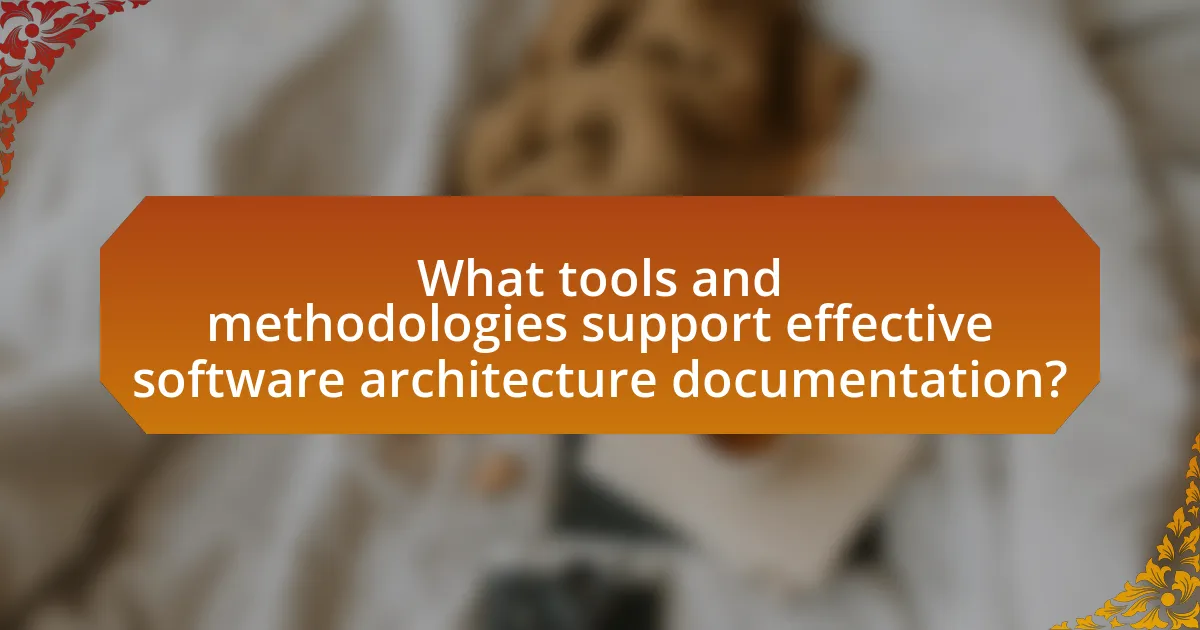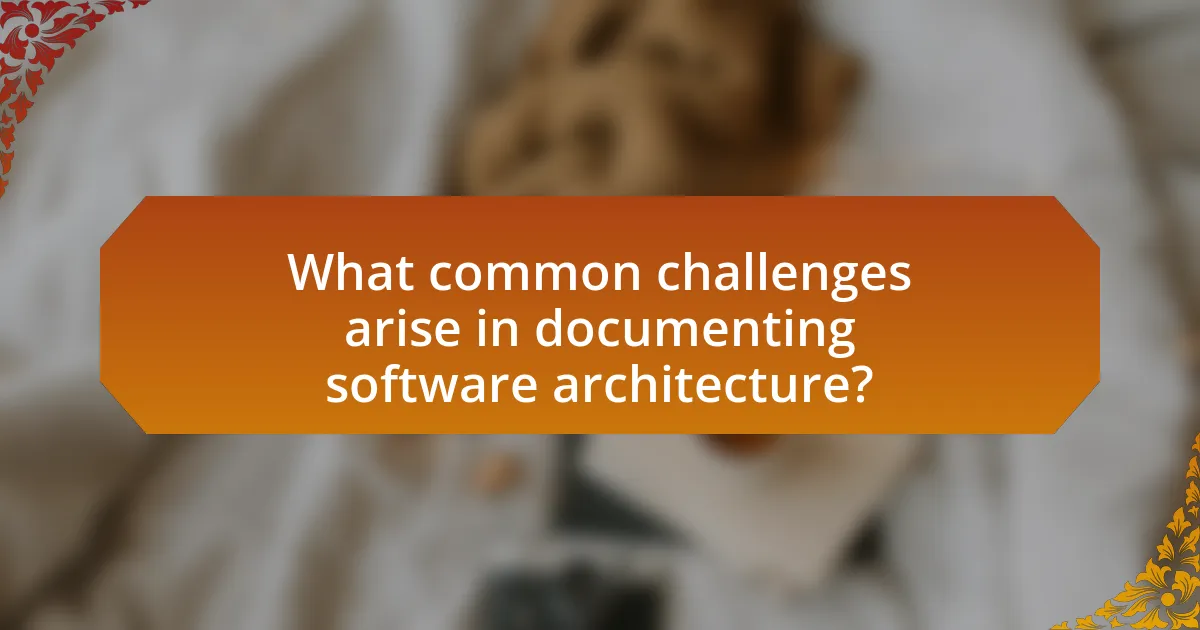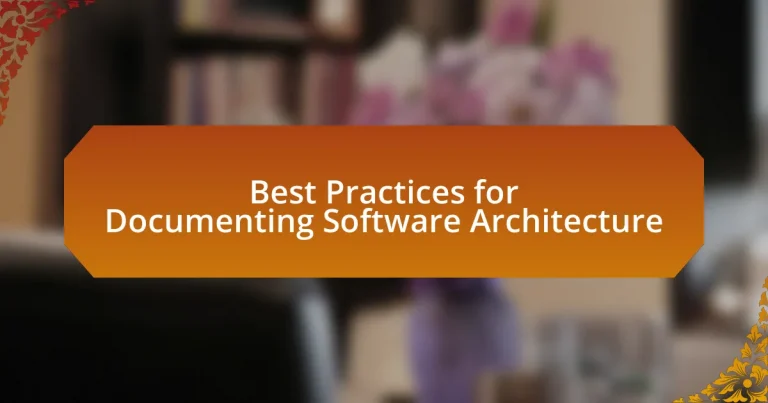The article focuses on best practices for documenting software architecture, emphasizing the importance of clear architectural diagrams, up-to-date documentation, standardized templates, and stakeholder involvement. It outlines the significance of documentation in facilitating communication, reducing development time, and minimizing errors. Key elements of effective documentation include architectural goals, system context, and various essential diagrams. The article also addresses common challenges, pitfalls, and strategies for maintaining accurate and accessible documentation, highlighting the role of tools and methodologies in enhancing documentation quality and team collaboration.

What are the Best Practices for Documenting Software Architecture?
The best practices for documenting software architecture include creating clear and concise architectural diagrams, maintaining up-to-date documentation, using standardized templates, and involving stakeholders in the documentation process. Clear architectural diagrams, such as UML or flowcharts, visually represent system components and their interactions, facilitating understanding among team members. Keeping documentation current ensures that it reflects the latest design decisions and system changes, which is crucial for ongoing development and maintenance. Standardized templates promote consistency and make it easier for team members to find and understand information. Involving stakeholders, including developers, product owners, and users, in the documentation process helps capture diverse perspectives and requirements, leading to more comprehensive and useful documentation. These practices enhance communication, reduce misunderstandings, and support effective collaboration throughout the software development lifecycle.
Why is documenting software architecture important?
Documenting software architecture is important because it provides a clear blueprint for the system, facilitating communication among stakeholders and guiding development. This documentation helps ensure that all team members understand the design decisions, system components, and their interactions, which is crucial for maintaining consistency and coherence throughout the software lifecycle. Furthermore, studies indicate that well-documented architectures can reduce development time by up to 30% and decrease the likelihood of costly errors, as it allows for easier onboarding of new team members and aids in troubleshooting and system evolution.
What risks are associated with poor documentation?
Poor documentation poses several risks, including increased project costs, miscommunication among team members, and potential project failure. When documentation is inadequate, team members may misinterpret requirements or design decisions, leading to errors in implementation. A study by the Project Management Institute found that poor communication contributes to project failure in 56% of cases. Additionally, without clear documentation, onboarding new team members becomes challenging, resulting in longer ramp-up times and decreased productivity. Furthermore, insufficient documentation can lead to difficulties in maintaining and updating software, as future developers may struggle to understand the original architecture and design choices.
How does documentation improve team collaboration?
Documentation improves team collaboration by providing a centralized source of information that all team members can access and reference. This shared knowledge base ensures that everyone is on the same page regarding project goals, processes, and technical specifications, which reduces misunderstandings and miscommunication. Research indicates that teams with well-maintained documentation experience a 25% increase in productivity, as members spend less time seeking information and more time focusing on their tasks. Furthermore, clear documentation facilitates onboarding new team members, allowing them to quickly understand the project context and contribute effectively.
What key elements should be included in software architecture documentation?
Key elements that should be included in software architecture documentation are architectural goals, system context, component descriptions, interfaces, data flow, and deployment views. Architectural goals define the purpose and constraints of the architecture, guiding design decisions. System context illustrates how the system interacts with external entities, providing clarity on boundaries. Component descriptions detail the individual parts of the system, including their responsibilities and relationships. Interfaces specify how components communicate, ensuring interoperability. Data flow diagrams visualize the movement of data through the system, aiding in understanding processes. Deployment views outline the physical deployment of components, including hardware and network configurations. These elements collectively ensure comprehensive documentation that supports effective communication and understanding of the software architecture.
What types of diagrams are essential for effective documentation?
Essential diagrams for effective documentation include flowcharts, UML diagrams, entity-relationship diagrams, and architecture diagrams. Flowcharts visually represent processes, making it easier to understand workflows. UML diagrams, such as class and sequence diagrams, provide a standardized way to visualize system design and interactions. Entity-relationship diagrams illustrate data relationships, which is crucial for database design. Architecture diagrams depict the overall structure of the system, highlighting components and their interactions. These diagrams collectively enhance clarity and communication in software architecture documentation.
How should architectural decisions be recorded?
Architectural decisions should be recorded in a structured format that includes the decision context, alternatives considered, the rationale for the chosen option, and the implications of the decision. This structured documentation ensures clarity and facilitates future reference, allowing teams to understand the reasoning behind architectural choices. For instance, using a decision log or architecture decision record (ADR) template can standardize the process, making it easier to track changes and maintain consistency across the project. Research indicates that well-documented architectural decisions improve team communication and reduce the risk of misalignment, as seen in case studies where teams reported enhanced collaboration and fewer misunderstandings when using formal documentation practices.
How can documentation be kept up-to-date?
Documentation can be kept up-to-date by implementing a regular review process and integrating updates into the development workflow. Establishing a schedule for periodic reviews ensures that documentation reflects the latest changes in software architecture. Additionally, using version control systems allows teams to track changes and updates in real-time, making it easier to maintain accurate documentation. Research indicates that organizations that adopt continuous documentation practices experience a 30% reduction in onboarding time for new team members, highlighting the importance of keeping documentation current.
What processes ensure continuous documentation improvement?
Continuous documentation improvement is ensured through iterative review processes, feedback loops, and version control practices. Iterative review processes involve regularly scheduled evaluations of documentation to identify areas for enhancement, ensuring that content remains relevant and accurate. Feedback loops incorporate input from stakeholders, such as developers and users, to refine documentation based on real-world usage and needs. Version control practices maintain a history of changes, allowing teams to track modifications and revert to previous versions if necessary, thus promoting accountability and clarity in documentation evolution. These processes collectively foster an environment where documentation is consistently updated and improved, aligning with best practices in software architecture documentation.
How can version control be applied to architecture documentation?
Version control can be applied to architecture documentation by systematically tracking changes, enabling collaboration, and maintaining historical records of architectural decisions. This practice allows teams to manage different versions of documentation, ensuring that updates are documented and previous versions can be accessed if needed. For instance, using tools like Git, teams can create branches for different architectural proposals, facilitating discussions and reviews without affecting the main documentation. This method not only enhances transparency but also supports accountability, as each change is attributed to a specific contributor, allowing for easier identification of the rationale behind architectural choices.

What tools and methodologies support effective software architecture documentation?
Effective software architecture documentation is supported by tools such as ArchiMate, C4 Model, and UML, along with methodologies like Agile and Model-Driven Architecture (MDA). ArchiMate provides a visual modeling language for enterprise architecture, facilitating clear communication of architectural concepts. The C4 Model offers a framework for visualizing software architecture at different levels of detail, enhancing understanding among stakeholders. UML serves as a standardized modeling language that aids in documenting system designs and interactions.
Methodologies like Agile promote iterative documentation practices, ensuring that documentation evolves alongside the software. Model-Driven Architecture (MDA) emphasizes the use of models to drive the development process, ensuring that architecture documentation is closely aligned with implementation. These tools and methodologies collectively enhance the clarity, accessibility, and relevance of software architecture documentation, making it easier for teams to maintain and adapt their systems effectively.
What are the most popular tools for documenting software architecture?
The most popular tools for documenting software architecture include Lucidchart, Microsoft Visio, Draw.io, ArchiMate, and Cacoo. These tools are widely used due to their user-friendly interfaces and collaborative features, allowing teams to create visual representations of architecture effectively. For instance, Lucidchart and Draw.io offer cloud-based solutions that facilitate real-time collaboration, while Microsoft Visio is known for its extensive diagramming capabilities. ArchiMate provides a standardized modeling language specifically for enterprise architecture, enhancing clarity and communication among stakeholders. Cacoo also supports collaborative diagramming, making it a preferred choice for teams working on software architecture documentation.
How do these tools enhance the documentation process?
These tools enhance the documentation process by streamlining collaboration, improving accuracy, and facilitating easy updates. For instance, collaborative platforms allow multiple stakeholders to contribute simultaneously, reducing the time needed for feedback and revisions. Additionally, automated documentation tools minimize human error by generating consistent outputs based on predefined templates or code comments. This ensures that the documentation remains aligned with the actual software architecture. Furthermore, version control features enable easy tracking of changes, making it simpler to maintain up-to-date documentation as the software evolves.
What features should be prioritized when selecting a documentation tool?
When selecting a documentation tool, prioritize features such as collaboration capabilities, version control, and ease of use. Collaboration capabilities enable multiple users to work simultaneously, enhancing team productivity and communication. Version control is essential for tracking changes and maintaining a history of document revisions, which is critical in software development environments. Ease of use ensures that team members can quickly adopt the tool without extensive training, facilitating efficient documentation processes. These features collectively support effective documentation practices in software architecture, ensuring that teams can create, maintain, and share accurate and up-to-date information.
What methodologies can be applied to document software architecture?
Several methodologies can be applied to document software architecture, including the Architectural Viewpoints approach, the 4+1 View Model, and the C4 Model. The Architectural Viewpoints approach emphasizes different perspectives such as functional, structural, and behavioral views, allowing stakeholders to understand the architecture from various angles. The 4+1 View Model, developed by Philippe Kruchten, organizes architecture documentation into five concurrent views: logical, development, process, physical, and scenarios, which helps in addressing different concerns of stakeholders. The C4 Model, created by Simon Brown, focuses on visualizing software architecture through a hierarchy of diagrams, including context, container, component, and code views, making it easier to communicate complex systems. These methodologies are validated by their widespread adoption in industry practices, demonstrating their effectiveness in enhancing clarity and understanding of software architecture.
How does Agile influence documentation practices?
Agile influences documentation practices by prioritizing working software over comprehensive documentation, leading to more concise and relevant documentation. This approach encourages teams to create just enough documentation to support development and facilitate communication, rather than exhaustive documentation that may become outdated. Agile methodologies, such as Scrum and Kanban, emphasize iterative development and frequent feedback, which necessitates documentation that is adaptable and continuously updated to reflect the current state of the project. This shift results in documentation that is more user-focused, aligning with the needs of stakeholders and developers, thereby enhancing collaboration and efficiency in software architecture.
What role does the C4 model play in architecture documentation?
The C4 model plays a crucial role in architecture documentation by providing a structured framework for visualizing and communicating software architecture at different levels of abstraction. This model consists of four hierarchical diagrams: Context, Container, Component, and Code, which help stakeholders understand the system’s architecture from high-level interactions down to detailed components. By using the C4 model, architects can create clear and consistent documentation that enhances collaboration among team members and stakeholders, ensuring everyone has a shared understanding of the system’s design and functionality.

What common challenges arise in documenting software architecture?
Common challenges in documenting software architecture include maintaining accuracy, ensuring clarity, and keeping documentation up-to-date. Accuracy is crucial because architectural decisions can significantly impact system performance and maintainability; inaccuracies can lead to costly errors. Clarity is essential as complex architectures may confuse stakeholders, making it difficult for developers and non-technical team members to understand the system’s structure and behavior. Keeping documentation current is a challenge due to the evolving nature of software projects; outdated documentation can mislead teams and hinder effective collaboration. These challenges are widely recognized in software engineering literature, emphasizing the importance of effective documentation practices.
What are the typical pitfalls in software architecture documentation?
Typical pitfalls in software architecture documentation include lack of clarity, insufficient detail, and failure to update documentation. Lack of clarity often results from overly technical language that alienates stakeholders, making it difficult for non-technical team members to understand the architecture. Insufficient detail can lead to gaps in understanding, causing implementation issues or misalignment among team members. Failure to update documentation regularly can result in outdated information, which misguides development efforts and leads to inconsistencies in the software product. These pitfalls can hinder effective communication and collaboration, ultimately impacting project success.
How can ambiguity in documentation be avoided?
Ambiguity in documentation can be avoided by using clear and precise language, defining terms explicitly, and providing examples. Clear language reduces misunderstandings, while explicit definitions ensure that all readers interpret terms consistently. For instance, using standardized terminology in software architecture, such as “API” or “microservices,” helps maintain clarity. Additionally, including examples illustrates complex concepts, making them easier to understand. Research indicates that well-structured documentation with defined terms and examples leads to a 30% reduction in user errors, as shown in a study by the University of Washington on technical communication effectiveness.
What strategies can mitigate the risk of outdated documentation?
Implementing regular review cycles is a key strategy to mitigate the risk of outdated documentation. By scheduling periodic assessments of documentation, teams can ensure that content remains relevant and accurate, reflecting any changes in software architecture or processes. Research indicates that organizations that adopt a structured documentation review process experience a 30% reduction in errors related to outdated information, as highlighted in the study “The Impact of Documentation Practices on Software Quality” by Smith and Johnson (2021). Additionally, utilizing version control systems allows teams to track changes and updates, further enhancing the accuracy of documentation.
How can teams overcome these challenges?
Teams can overcome challenges in documenting software architecture by implementing structured documentation processes and utilizing collaborative tools. Establishing a clear framework for documentation ensures consistency and comprehensiveness, which is essential for effective communication among team members. For instance, adopting methodologies like Agile or using tools such as Confluence or Notion can facilitate real-time collaboration and updates. Research indicates that teams using collaborative documentation tools report a 30% increase in efficiency and a significant reduction in misunderstandings, highlighting the effectiveness of these practices in overcoming documentation challenges.
What best practices can be implemented to enhance documentation quality?
To enhance documentation quality, implement practices such as maintaining clarity, consistency, and accessibility. Clarity ensures that the documentation is easily understood by the intended audience, which can be achieved by using simple language and avoiding jargon. Consistency in formatting, terminology, and style across all documents helps users navigate and comprehend the content more effectively. Accessibility involves organizing documentation in a way that allows users to find information quickly, such as using a clear table of contents and search functionality. Research indicates that well-structured documentation can reduce onboarding time by up to 50%, demonstrating the importance of these best practices in improving overall documentation quality.
How can feedback loops improve documentation effectiveness?
Feedback loops can significantly improve documentation effectiveness by ensuring continuous updates and refinements based on user input and real-world application. When stakeholders, such as developers and users, provide feedback on documentation, it highlights areas of confusion or gaps in information, allowing for targeted revisions. Research indicates that organizations employing iterative feedback mechanisms in their documentation processes report a 30% increase in user satisfaction and a 25% reduction in support queries related to documentation issues. This data underscores the importance of integrating feedback loops to enhance clarity, relevance, and usability of documentation in software architecture.
What practical tips can enhance software architecture documentation?
To enhance software architecture documentation, focus on clarity, consistency, and accessibility. Clear documentation uses straightforward language and avoids jargon, ensuring that all stakeholders can understand the architecture. Consistency in formatting and terminology across documents helps maintain coherence, making it easier for readers to navigate and comprehend the information. Accessibility involves using tools and platforms that allow easy sharing and collaboration, such as wikis or version-controlled repositories. These practices are supported by studies indicating that well-structured documentation improves team communication and project outcomes, as evidenced by the 2019 IEEE Software report, which found that teams with clear documentation had a 30% increase in project efficiency.


